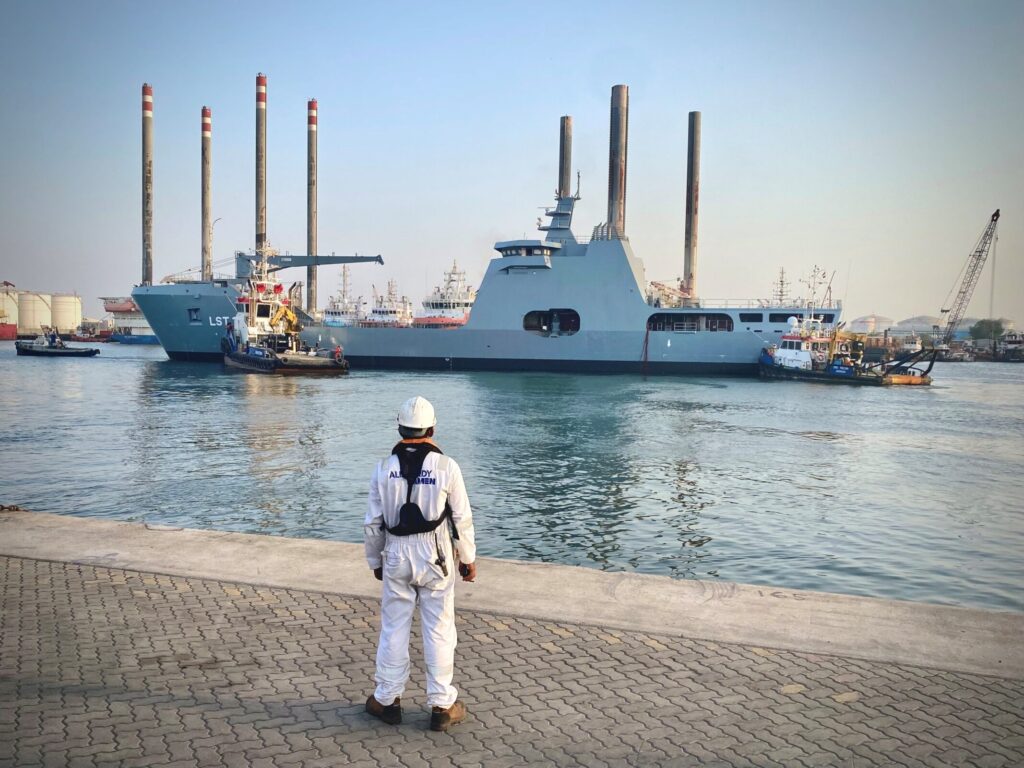The delivery and official handover of the Landing Ship Transport (LST) 100 to the Nigerian Navy is fast approaching. Most of the systems on board have now been put into operation after successful testing during the Harbour Acceptance Tests. The month of December will focus on the sea trials of this advanced multi-purpose landing vessel; the LST 100 will then be tested at sea. If nothing untoward happens, the military roll-on roll-off vessel can be formally handed over to the Nigerian Navy on 9 March 2022.
Project Director Sander Boost is confident that the handover can take place as planned on that date. “But of course, I won’t be cheering until we cross the finish line,” he says, laughing. Meanwhile, the project is in its final phase. The commissioning of the LST 100 and the associated Harbour Acceptance Test (HAT) – the ‘setting to work’ process – is 95 per cent complete, adds Sander. “During commissioning, there was a detailed check that all systems on board had been installed properly and the HAT then had to show whether those systems were actually functioning as they should, which fortunately was the case.”
 The LST 100 during the launch at the Albwardy Damen shipyard in Sharjah, United Arab Emirates.
The LST 100 during the launch at the Albwardy Damen shipyard in Sharjah, United Arab Emirates.
The Project Team is now focusing on the upcoming sea trials, which will take place from 12 December. By that date, commissioning and HAT must be complete. “We are going to divide these sea trials, the Sea Acceptance Trials (SAT), into two parts,” continues Sander. “Before Christmas all the platform systems will be tested, and after Christmas the SAT will have a follow-up, where most of the weapon systems on board will be tested.” The test runs of the 100-metre-long and 16-metre-wide landing craft for Nigeria will take place in the Arabian Gulf within the twelve-mile zone of the United Arab Emirates, the country where the vessel was built at the Damen shipyard in Sharjah.
“There will be around fifty people on board during the SAT,” says Sander. “In addition to the ship’s future crew, this includes representatives from the suppliers of various critical systems on board. In the unlikely event of a problem occurring, these specialists will be able to take immediate action.” Sander himself will of course also be on board. He is looking forward to it, he says. “The sea trials are a crucial part of the project. The ship must then demonstrate that it can easily reach the agreed maximum speed of 15 knots, or that it can make a super-short turning circle and perform an emergency stop without any problems, to mention just a few of the points that need to be ticked off the list.”
“The work is nicely on schedule and although Covid-19 is still lurking, everything indicates that the delivery on 9 March 2022 can still be achieved.” Project Director Sander Boost
In the run-up to delivery, the SAT will be followed by a period in which any remaining issues revealed by the sea trials will be resolved. “The work is nicely on schedule and although Covid-19 is still lurking, everything indicates that the delivery on 9 March 2022 can still be achieved,” concludes Sander. “Nigeria’s Chief of Naval Staff, Vice Admiral Awwal Zubairu Gambo, is likely to be present at this special moment.”
The LST 100 is designed for a wide variety of tasks. The ship is designed to carry out amphibious operations in which it sails from the sea onto the beach, or vice versa. It can carry 250 troops. But the Nigerian Navy also wants to use the landing craft to increase maritime security in the Gulf of Guinea. The LST 100, equipped with a helicopter deck, will also assist in disaster relief operations and will be used for other humanitarian operations.

